Kuala Lumpur: Heart of the Malay Peninsula
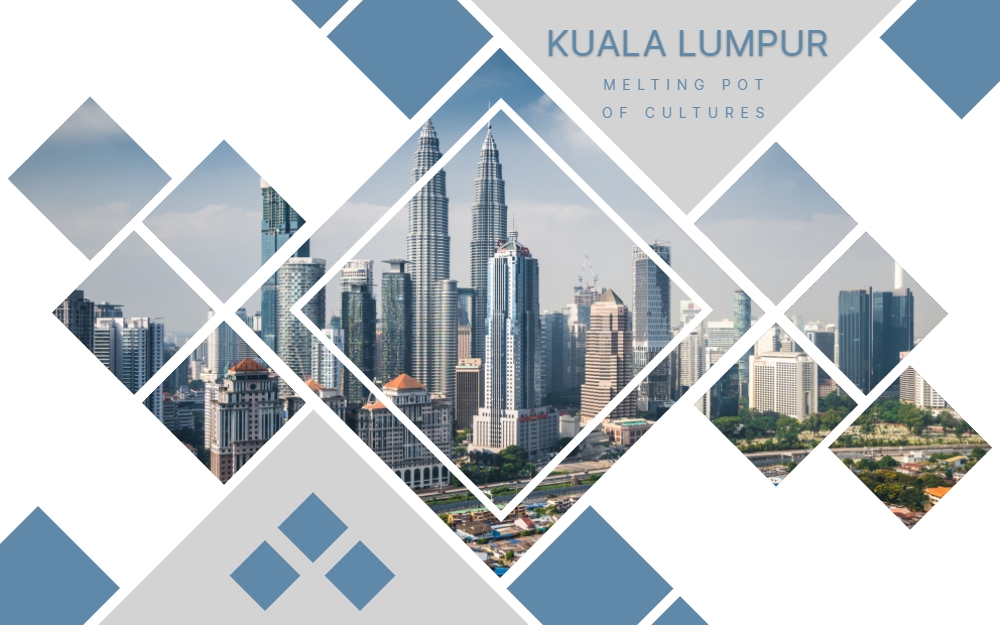
Kuala Lumpur, often referred to as “KL,” is the vibrant and dynamic capital city of Malaysia. Nestled in the heart of the Malay Peninsula, this bustling metropolis is a melting pot of cultures, a testament to the country’s rich diversity. With a population that represents a kaleidoscope of ethnicities, including Malays, Chinese, Indians, and indigenous groups, the city exudes a unique and harmonious blend of traditions, languages, and cuisines.
One of Kuala Lumpur’s most iconic landmarks is the Petronas Twin Towers, a pair of majestic skyscrapers that stand as a symbol of the city’s rapid modernization and economic growth. The cityscape is a juxtaposition of these towering structures and colonial-era architecture, reflecting Malaysia’s journey from its colonial past to its present as a progressive nation.
Kuala Lumpur offers a feast for the senses. The bustling streets are alive with the aroma of street food, where you can savour local delicacies like nasi lemak and char kway teow. The vibrant street markets, such as Bukit Bintang and Petaling Street, are perfect for shopping, while the serene Lake Gardens provide a green oasis amidst the urban sprawl.
The city also boasts a rich cultural scene with museums, galleries, and performance venues that celebrate its heritage and contemporary art. The Batu Caves, just a short trip from the city centre, are a must-visit, featuring stunning limestone caves adorned with Hindu shrines and vibrant festivals.
In Kuala Lumpur, you can explore the harmonious coexistence of tradition and modernity, making it a truly captivating and diverse destination for travellers seeking an authentic Southeast Asian experience.
Tourist Attraction Places in Kuala Lumpur
Kuala Lumpur is a bustling city with a wide range of tourist attractions. Here is a list of some of the most popular places to visit in the Malaysian capital:
1. Petronas Twin Towers: These iconic twin skyscrapers are a symbol of Kuala Lumpur and offer breathtaking views of the city from their observation decks.
2. Batu Caves: A series of caves and cave temples located within limestone hills, these are dedicated to Lord Murugan and are known for their colourful, religious statues and the annual Thaipusam festival.
3. Merdeka Square: This historic square is home to the Sultan Abdul Samad Building, the Royal Selangor Club, and the 100-meter flagpole where the Malaysian flag was first hoisted.
4. Islamic Arts Museum Malaysia: One of the largest Islamic art museums in Southeast Asia, it houses an impressive collection of Islamic artefacts, art, and manuscripts.
5. KL Tower (Menara KL): This communications tower offers panoramic views of the city and features a revolving restaurant.
6. Chinatown (Petaling Street): A bustling market area with shops, street food stalls, and a lively atmosphere.
7. Little India (Brickfields): Known for its colourful streets, Indian restaurants, and shops selling saris and spices.
8. Sultan Abdul Samad Building: A stunning example of Moorish architecture, this historic building is located in Merdeka Square.
9. Lake Gardens (Perdana Botanical Garden): A lush, green oasis in the heart of the city, featuring a bird park, butterfly park, and botanical gardens.
10. National Mosque (Masjid Negara): A striking modern mosque that can accommodate thousands of worshippers.
11. Aquaria KLCC: An underwater aquarium located beneath the Kuala Lumpur Convention Centre, home to a variety of marine life.
12. Sunway Lagoon Theme Park: Located just outside the city, it’s a fun-filled destination with water rides, a zoo, and various themed attractions.
13. Kuala Lumpur Bird Park: The world’s largest free-flight walk-in aviary where you can get up close with a variety of bird species.
14. Royal Selangor Pewter Factory and Visitor Centre: A chance to see the pewter-making process and purchase pewter souvenirs.
15. KL Forest Eco Park: A lush forest reserve at the base of KL Tower, offering jungle trails and a canopy walkway.
These are just some of the attractions you can explore in Kuala Lumpur, a city that seamlessly blends modernity with tradition, offering something for every type of traveller.
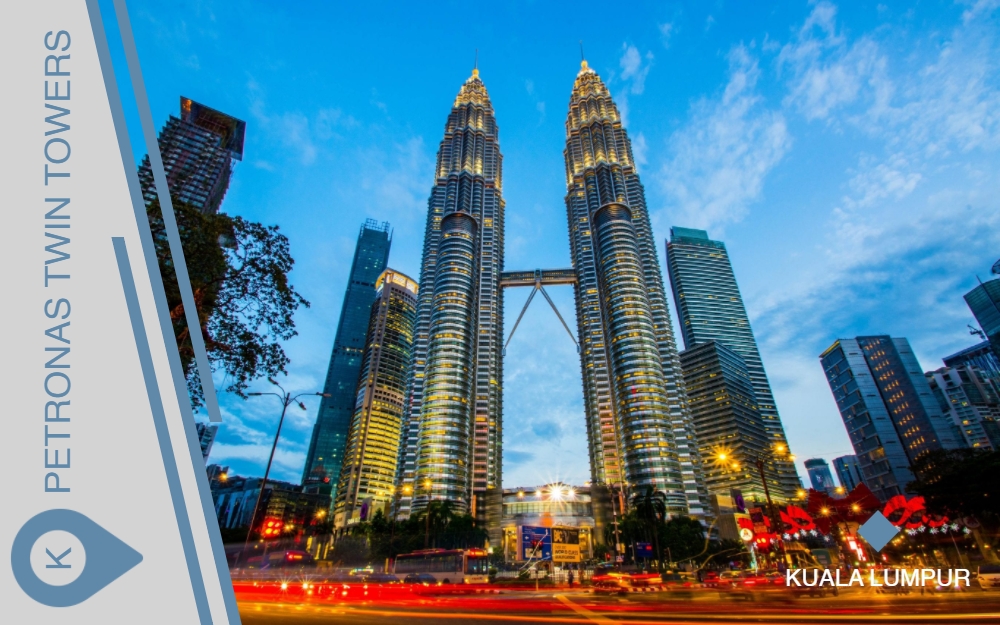
Petronas Twin Towers
The Petronas Twin Towers, located in Kuala Lumpur, Malaysia, stand as an iconic symbol of modern architectural and engineering excellence. Completed in 1998, they held the title of the world’s tallest twin towers until 2004, and they remain one of the most recognized landmarks in Southeast Asia. Designed by the renowned architect Cesar Pelli, these towers are a testament to Malaysia’s economic growth and ambition.
Rising to a staggering height of 451.9 meters (1,483 feet), the towers boast 88 floors of mixed-use space, including offices, commercial centres, and a sky bridge connecting the two structures at the 41st and 42nd floors. The sky bridge is both a functional element and a stunning architectural feature, offering breathtaking panoramic views of the city and serving as a symbol of connection and unity.
Constructed primarily of reinforced concrete and steel, the Petronas Twin Towers are an engineering marvel. The innovative design incorporates a tube-in-tube structure, which enhances their structural integrity and stability, particularly in the face of high winds and seismic activity. The towers’ distinctive silver façade and Islamic-inspired geometric motifs give them a unique aesthetic appeal, blending tradition with modernity.
Tourists and visitors from around the world flock to the towers to marvel at their beauty, visit the observation deck, and explore the Suria KLCC shopping mall at their base. By night, the towers are illuminated, creating a dazzling spectacle against the Kuala Lumpur skyline.
The Petronas Twin Towers represent not only Malaysia’s economic success but also its commitment to innovative architecture and sustainable development. They continue to symbolize the country’s progressive spirit and remain a source of national pride.
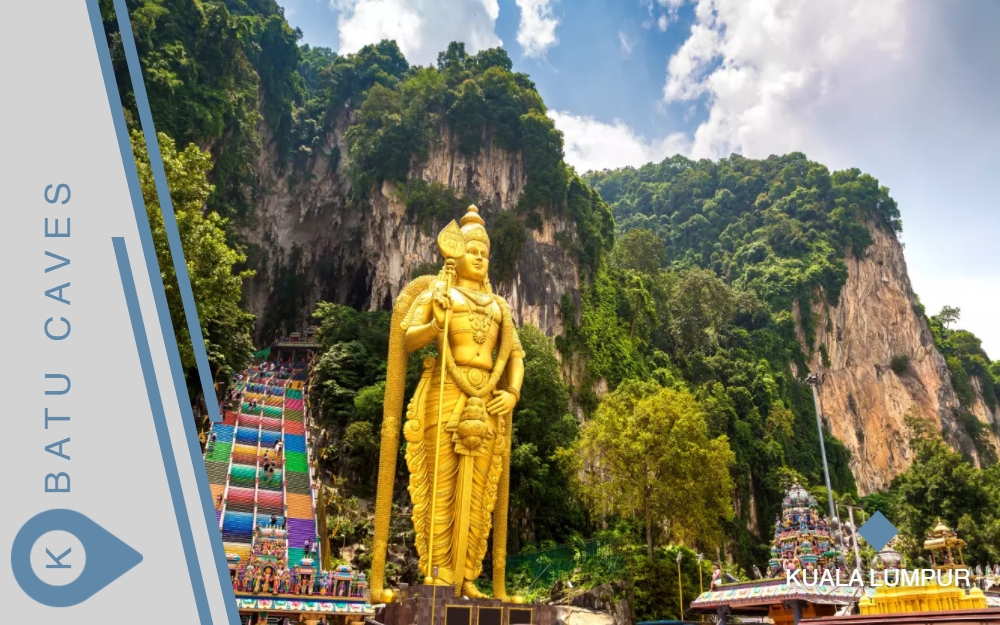
Batu Caves
Batu Caves, located just north of Kuala Lumpur, Malaysia, is an iconic and revered site that holds both natural and cultural significance. These limestone caves, which are more than 400 million years old, have been transformed into a sacred Hindu pilgrimage site, attracting tourists and devotees alike.
The most prominent feature of Batu Caves is the enormous golden statue of Lord Murugan, a Hindu deity, which stands guard at the entrance. This statue, at 42.7 meters (140 feet), is one of the tallest in the world and serves as a powerful symbol of faith and spirituality.
Visitors must ascend a steep flight of 272 colourful steps to reach the main cave temple, known as the Cathedral Cave. As they climb, they are greeted by the chirping of birds and the sight of cheeky monkeys, which are known to inhabit the area. Once at the top, visitors are rewarded with breathtaking views of the surrounding area and the city in the distance.
Inside the Cathedral Cave, visitors are greeted by stunning natural formations and a sense of tranquillity. The cave is adorned with Hindu shrines and religious icons, and it is often filled with the sound of chanting and the scent of incense. It’s a place of prayer, meditation, and reflection for Hindus.
Batu Caves is a site of cultural celebration as well. Every year, during the Thaipusam festival, which usually falls in January or February, thousands of devotees gather at the caves to pay homage to Lord Murugan. Many carry kavadis – elaborate structures adorned with spikes and milk pots – as part of their penance, making this festival a visually spectacular event.
In addition to its religious and cultural significance, Batu Caves is a popular tourist attraction, drawing visitors from around the world. It offers a unique blend of natural beauty, spirituality, and cultural richness that continues to captivate all who venture up its steps.
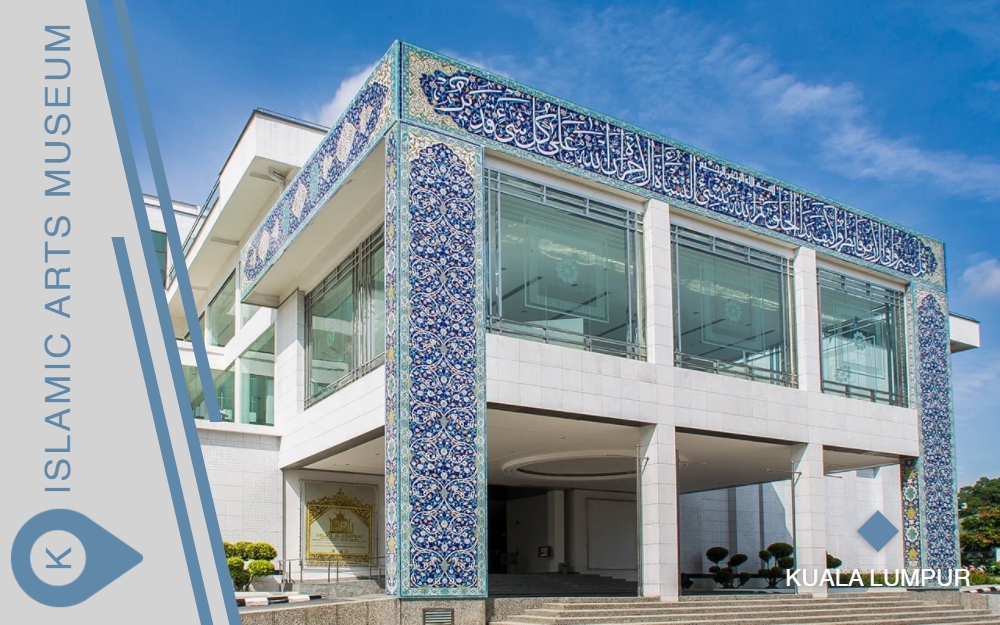
Islamic Arts Museum Malaysia
The Islamic Arts Museum Malaysia (IAMM) is a cultural gem located in Kuala Lumpur, Malaysia, celebrated for its dedication to preserving and showcasing the rich artistic heritage of the Islamic world. Established in 1998, the museum stands as one of the most comprehensive institutions of its kind, dedicated solely to Islamic art and culture.
Housed in an architectural marvel with a blend of traditional and contemporary design elements, IAMM offers visitors an opportunity to immerse themselves in the diverse world of Islamic art. The museum’s extensive collection includes artefacts from across the Islamic world, spanning more than 1,400 years of history. It features stunning displays of Islamic calligraphy, textiles, ceramics, jewellery, manuscripts, and architectural pieces, each with intricate designs and profound cultural significance.
The museum is organized into several galleries, each thoughtfully curated to offer a thematic and chronological journey through Islamic art and culture. These galleries explore different aspects of Islamic civilization, showcasing the contributions of various regions and time periods, from the Islamic golden age to contemporary Islamic art.
One of the standout features of the IAMM is its dedication to educational outreach. The museum frequently hosts exhibitions, lectures, and workshops that offer visitors a deeper understanding of the art, history, and culture of the Islamic world. It also houses a comprehensive library that is a valuable resource for scholars and enthusiasts.
The Islamic Arts Museum Malaysia plays a crucial role in fostering cross-cultural understanding and appreciation for the rich artistic traditions of the Islamic world. It is a testament to Malaysia’s commitment to promoting cultural diversity and preserving the artistic legacy of the Muslim world, making it a must-visit destination for anyone interested in the beauty and history of Islamic art.
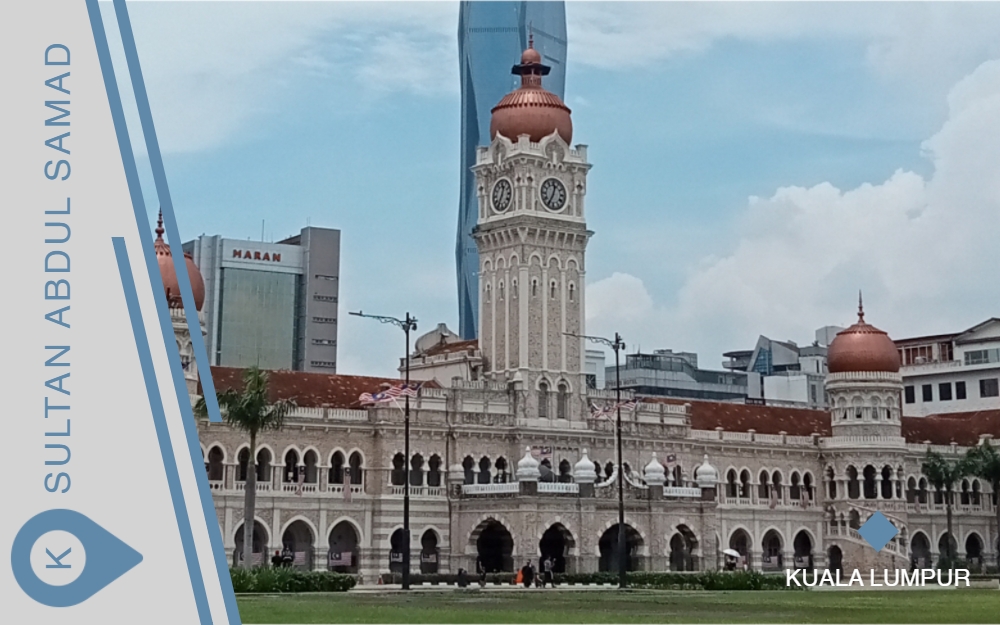
Sultan Abdul Samad Building
The Sultan Abdul Samad Building, a magnificent historical landmark located in Kuala Lumpur, Malaysia, stands as an enduring testament to the country’s rich colonial heritage and architectural grandeur. Built during the late 19th century, this iconic structure is named after Sultan Abdul Samad, the reigning Sultan of Selangor at the time it was constructed.
The building is a classic example of Moorish and Mughal architectural influences, with its distinctive design elements including graceful arches, intricate details, and a prominent clock tower. The building was originally designed by British architect A.C. Norman, and its construction was completed in 1897, making it one of the oldest and most iconic landmarks in the city.
Over the years, the Sultan Abdul Samad Building has played various roles, including housing several important government offices and departments. Today, it is primarily the backdrop for Malaysia’s significant national events and celebrations. The building’s picturesque location at Merdeka Square makes it a focal point during national holidays, especially during Malaysia’s Independence Day celebrations on August 31st.
The copper-domed clock tower, which adorns the building, is a striking feature that often serves as a symbol of Kuala Lumpur. The clock was sourced from England and remains an important timekeeping device in the city.
Beyond its architectural grandeur, the Sultan Abdul Samad Building stands as a historical witness to Malaysia’s journey from colonial rule to independence. It is an embodiment of the nation’s enduring cultural heritage and a reminder of the rich tapestry of influences that have shaped the country.
Visitors to Kuala Lumpur often marvel at the building’s aesthetic beauty and its role in preserving and commemorating Malaysia’s past, making it a must-see destination for anyone interested in the history and architecture of this vibrant nation.
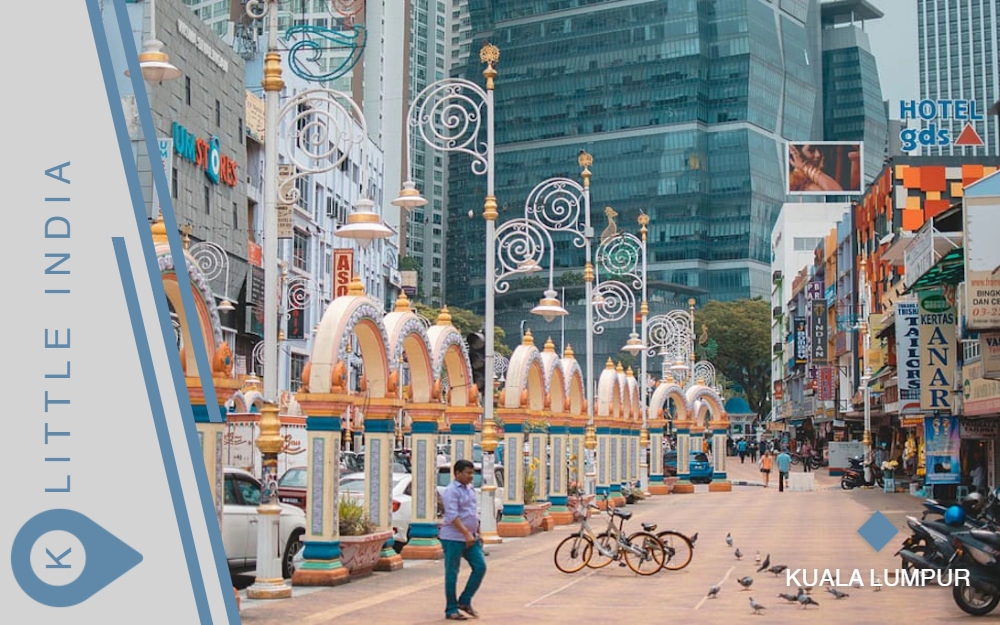
Little India (Brickfields)
Little India is a vibrant and culturally rich district found in various cities around the world, most notably in Singapore, Kuala Lumpur, and Penang in Malaysia. It’s a lively enclave that serves as a microcosm of the Indian diaspora, offering visitors a unique opportunity to experience Indian culture, cuisine, and traditions.
In Little India, you’ll find a bustling hub of activity filled with colourful streets, shops, and market stalls. The architecture is often adorned with intricate designs, and the streets are adorned with vibrant decorations and fragrant flower garlands. Little India is a sensory delight, with the aroma of spices, the sound of Bollywood music, and the vivid colours of traditional clothing and textiles.
One of the key attractions in Little India is the variety of Indian food. The area is renowned for its diverse culinary offerings, from street-side stalls selling savoury dosas and spicy curries to more upscale restaurants serving tandoori specialities and biryanis. It’s a food lover’s paradise, and a visit isn’t complete without trying dishes like samosas, and masala chai, and sweets like jalebi or gulab jamun.
Little India is also home to various shops and markets where you can purchase traditional Indian clothing, jewellery, fabrics, and handicrafts. Many stores specialize in sarees and accessories, making it a popular destination for those looking to immerse themselves in Indian fashion and style.
Cultural celebrations and festivals are an integral part of life in Little India. During Diwali, Navaratri, or other Indian festivals, the streets come alive with colourful decorations, traditional music, and joyful celebrations.
Little India is a wonderful place to experience the vibrant and diverse culture of India without leaving the city. It’s a reminder of the global influence and contributions of the Indian diaspora and offers a warm and welcoming atmosphere for both locals and visitors alike.
For more exciting news and facts, check out our website New Facts World and follow us on Instagram.



